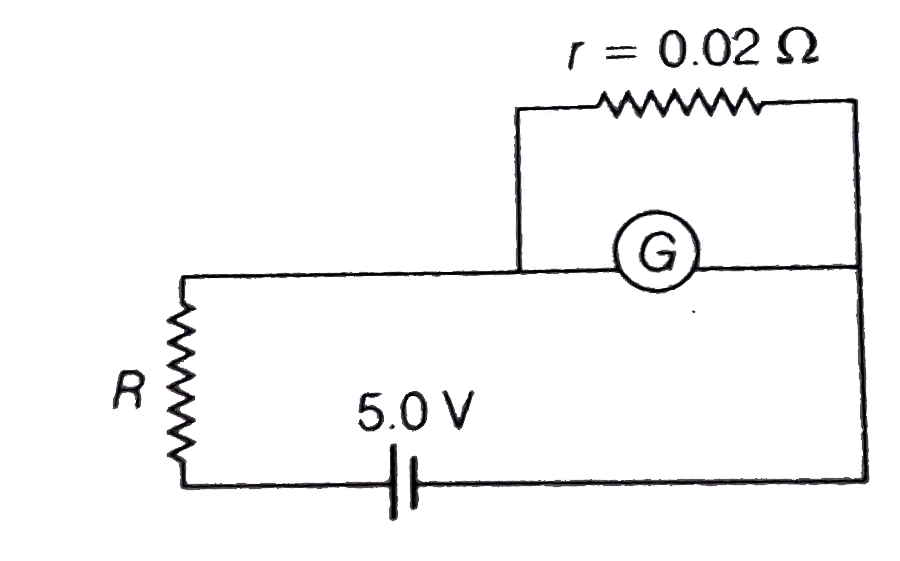A galvanometer having a resistance of 8 ohm is shunted by a wire of resistance 2 ohm . If the total current is 1 amp , the part of it passing through the shunt will be
0.5 A
0.2 A
0.8 A
0.25 A
The correct Answer is:(iii)
To solve the problem step by step, we need to analyze the circuit involving the galvanometer and the shunt resistor. Here’s how we can approach it:
Step 1: Understand the Circuit
We have a galvanometer with a resistance Rg=8Ω and a shunt resistor with a resistance Rs=2Ω. The total current flowing into the circuit is I=1A.
Step 2: Set Up the Current Division
Let Is be the current flowing through the shunt resistor. The current flowing through the galvanometer will then be Ig=I−Is.
Step 3: Apply the Concept of Parallel Resistors
Since the galvanometer and the shunt resistor are in parallel, the voltage across both resistors is the same. Therefore, we can write the following equation based on Ohm's Law:
Is⋅Rs=(I−Is)⋅Rg
Step 4: Substitute the Known Values
Substituting the known values into the equation:
Is⋅2=(1−Is)⋅8
Step 5: Expand and Rearrange the Equation
Expanding the equation gives:
2Is=8−8Is
Now, rearranging the equation to isolate Is:
2Is+8Is=8
10Is=8
Step 6: Solve for Is
Now, divide both sides by 10:
Is=810=0.8A
Conclusion
The part of the total current passing through the shunt resistor is 0.8A.
---
We have a galvanometer with a resistance Rg=8Ω and a shunt resistor with a resistance Rs=2Ω. The total current flowing into the circuit is I=1A.
Let Is be the current flowing through the shunt resistor. The current flowing through the galvanometer will then be Ig=I−Is.
Since the galvanometer and the shunt resistor are in parallel, the voltage across both resistors is the same. Therefore, we can write the following equation based on Ohm's Law:
Substituting the known values into the equation:
Expanding the equation gives:
Now, divide both sides by 10:
The part of the total current passing through the shunt resistor is 0.8A.
Topper's Solved these Questions
- MOVING CHARGES AND MAGNETISMBOOK - AAKASH INSTITUTE ENGLISHCHAPTER - MOVING CHARGES AND MAGNETISMEXERCISE - Assignment (Section A) Objective Type Questions (One option is correct)
55 Videos
- MOVING CHARGES AND MAGNETISMBOOK - AAKASH INSTITUTE ENGLISHCHAPTER - MOVING CHARGES AND MAGNETISMEXERCISE - Assignment (Section B) Objective Type Questions (One option is correct)
35 Videos
- MOVING CHARGES AND MAGNETISMBOOK - AAKASH INSTITUTE ENGLISHCHAPTER - MOVING CHARGES AND MAGNETISMEXERCISE - Illustration
14 Videos
- MOVING CHARGE AND MAGNESIUMBOOK - AAKASH INSTITUTE ENGLISHCHAPTER - MOVING CHARGE AND MAGNESIUMEXERCISE - SECTION D
16 Videos
- NUCLEIBOOK - AAKASH INSTITUTE ENGLISHCHAPTER - NUCLEIEXERCISE - ASSIGNMENT (SECTION-D)
10 Videos
Similar Questions
A galvanometer of resistance G is shunted by a resistance Sohm. To keep the main current in the circuit uncharged, the resistnace to be put in series with the galvonmeter
View SolutionA galvanometer of resistance 20Ω is shunted by a 2Ω resistor. What part of the main current flows through the galvanometer ?
View SolutionA galvanometer has a resistance of 3663Ω. A shunt S is connected across it such that (1/34) of the total current passes through the galvanometer. Then the value of the shunt is
View SolutionA galvanometer has a resistance of 3663Ω. A shunt S is connected across it such that (1/34) of the total current passes through the galvanometer. Then the value of the shunt is
View SolutionA galvanometer of resistance 150 ohm is shunted such that only 1/11 of the main current flows through the galvanometer. The resistance of the shunt is, (in ohm)
View SolutionWe have a galvanometer of resistance 25Ω. It is shunted by a 2.5Ω wire. The part of total current that flows through the galvanometer is given as
View SolutionIn the circuit, shown the galvanometer G of resistance 60Ω is shifted by a resistance r=0.02Ω. The current through R is nearly 1A. The value of resistance R (in ohm) is nearly.

View SolutionA galvanometer has resistance 500 ohm. It is shunted so that its sensitivity decreases by 100 times. Find the shunt resistance.
View SolutionA galvanometer has a resistance of 98Ω. If 2% of the main current is to be passed through the meter what should be the value of the shunt?
View SolutionA current of 2 A is passed through a coil of resistance 75 ohm for 2 minutes
How much charge is passed through the resistance ?
View Solution
